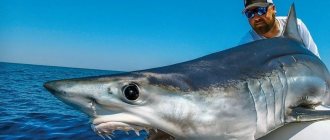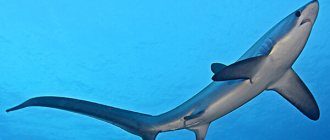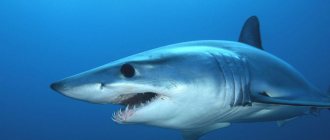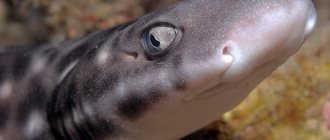Sharks are considered one of the most dangerous inhabitants of the seas and oceans - every year they commit hundreds of attacks on people, and in about ten cases they kill their victims. At the moment, scientists know more than 360 species of underwater predators, among which there are both small and defenseless and huge man-eating sharks. A large number of films have already been made about them, starting from the classic “Jaws” in 1975, and ending with the relatively recent “Meg: Monster of the Depth” in 2022. But are they as scary as they appear in the movies?
Nobody wants to meet a shark in the ocean.
Despite the great diversity, only 10 species of sharks are considered truly dangerous to people. Scientists recently discovered that they all descended from the same ancestor, who lived on Earth about 165 million years ago. The ancestor of modern killers was not as scary as one might initially assume - the length of the ancient shark Palaeocarcharias stromeri did not exceed one meter, and it fed exclusively on small fish. Her descendants are much scarier and more dangerous.
In 2022, Universal released the film "Toxic Shark" (Russian title: Poisonous Shark or Toxic Shark ). This is a science fiction film about a poisonous shark that uses toxic poison, destroying everything in its path.
Reef shark
This shark species primarily lives in the Indian and Pacific oceans. They prefer clear water and are often found near coral reefs and underwater cliffs. In addition to the fact that they can frighten with a chilling look, they are very large in size - the length of a reef shark reaches two meters.
Despite all this, they attack people extremely rarely - in 2011, there were only 11 known cases of reef shark attacks on people, and none of them were fatal. Sharks only show aggression if provoked, but in calm circumstances they easily swim up to divers and allow themselves to be hand-fed.
This shark doesn't look scary at all.
Description
The whitetip shark is relatively small in size: its maximum recorded length is 2.1 meters, average specimens are usually within 1.6 meters and weigh about 20 kg. The body of a reef shark is quite typical for sharks that inhabit underwater rocks and coral atolls. The elongated, narrow shape, slightly flattened at the front, is ideal for living and hunting in reef environments. The whitetip shark's head is wide and flat, its eyes are large and oval with special nictitating membranes (third eyelid). Body color is gray, brown or brown, sometimes with darker spots; the belly is light, almost white. A distinctive feature that gives the name to the species is that the tips of the first dorsal and caudal fins are painted white.
lemon shark
This species of shark typically lives in shallow bays - parts of the seas separated from open waters by rocks that protect them from wind and waves. The length of adult individuals is about 3 meters, and the weight reaches 180 kilograms. Typically, these sharks hunt only at night, and primarily feed on fish and shellfish.
Due to their large size, they are considered potentially life-threatening to humans. However, no fatal attacks have yet been recorded in history. There is a known case when a lemon shark attacked a diver with a GoPro camera - fortunately, the person was not injured, which cannot be said about the recording equipment.
Interaction with people[edit]
Gray reef sharks often show curiosity towards divers when they first enter the water and can get quite close, although they lose interest on repeated dives. [4] They can become dangerous in the presence of food and tend to be more aggressive if found in open water rather than on a reef. [13] There have been several known cases of spearfishers being attacked, possibly by mistake, when a shark struck a spearfish near the diver. This species will also attack if chased or cornered, and divers should immediately retreat (slowly and always facing the shark) if it begins to show threat. [4] You should not attempt to photograph the display, as camera flash has been known to trigger at least one attack.[3] Despite their modest size, they are capable of causing significant damage: during one threat mapping study, a gray reef shark attacked the researchers' submersible several times, leaving teeth marks in the plastic windows and biting off one of the propellers. . The shark attacked consistently from a distance of 6 m (20 ft), which it could cover in a third of a second. [14] As of 2008, the International Shark Attack File lists seven unprovoked and six provoked attacks (none of which were fatal) attributed to the species. [29]
Although gray reef sharks are still abundant in pristine areas, they are subject to local depletion due to their slow reproductive rate, specific habitat requirements, and tendency to remain in a specific area. The IUCN has assessed the gray reef shark as endangered; this shark is caught in multispecies fisheries in many parts of its range and is used to produce a variety of products such as shark fin soup and fishmeal. [2] Another threat is the ongoing degradation of coral reefs due to human development. There is evidence of significant declines in some populations. Anderson et al.
(1998) reported that in the Chagos Archipelago, gray reef shark abundance in 1996 had fallen to 14% of 1970s levels.
[30] Robbins et al.
(2006) found that gray reef shark populations in Great Barrier Reef fishing zones had declined by 97% compared to no-boat zones. Additionally, exclusion zones (boats are allowed but fishing is prohibited) had similar levels of depletion as fishing zones, indicating the severe impact of poaching. The shark population is projected to fall to 0.1% of pre-exploitation levels within 20 years without additional conservation measures. [31] One possible way to conserve the environment is through ecotourism, as gray reef sharks are suitable for shark sightings and lucrative dive sites are now protected in many countries, such as the Maldives. [6]
Blue shark
Blue sharks are considered the most common on Earth - you can meet them both in the open ocean and on the coasts of different countries. Their body length reaches four meters, and their weight is 400 kilograms. This type of shark has practically no enemies, with the exception of people who catch them both for entertainment and for cooking.
Of course, because of such hostility, people often become their victims. Thus, in 2011, 34 attacks by blue sharks were recorded, resulting in the death of 8 people. In 2022, there were even more victims - these predators ate more than 30 people off the coast of the Mediterranean Sea.
Blue shark himself.
Taxonomy and phylogeny[edit]
Dutch ichthyologist Pieter Bleecker first described the gray reef shark in 1856 as Carcharias (Prionodon) amblyrhynchos
in the scientific journal
Natuurkundig Tijdschrift voor Nederlandsch-Indië
.
Authors later transferred the species to the genus Carcharhinus
. The type specimen was 1.5 meters (4.9 ft) longer than the female from the Java Sea. [4] Other common names used for this shark worldwide include black whalers, bronze whalers, Fowler's whale sharks, graceful sharks, graceful whale sharks, gray sharks, gray whaler sharks, longnose blacktail sharks, school sharks, and shortnose blacktail sharks. Some of these names apply to other species as well. [2]
In earlier literature, the scientific name of this species was often given as C. menisorrah
.
[5] The black-tailed reef shark ( C. wheeleri
), native to the western Indian Ocean, is now considered by most authors to be the same species as the gray reef shark.
It was originally distinguished from the gray reef shark by the white tip of the first dorsal fin, a shorter snout, and one fewer upper row of teeth on each side. [6] Based on morphological characteristics, number of vertebrae, and tooth shape, Garrick (1982) concluded that the gray reef shark is most closely related to the silverback shark ( C. albimarginatus
). [7] This interpretation was supported by Lavery's 1992 phylogenetic analysis of allozymes. [8]
sand shark
This type of shark is also widespread and is found in almost all warm seas. They prefer to live close to the shore, and spend most of their time at the bottom, feeding on small fish, stingrays and other aquatic life. It is noteworthy that sand sharks are the only predators of their kind that can swallow air for easier swimming on the water surface.
Statistics say that from 1990 to 2011, sand sharks attacked people as many as 30 times - one person could not be saved and he died. Despite this, aquarium owners still consider sand sharks to be relatively safe creatures and place them inside huge aquariums, allowing visitors to swim next to them.
Great hammerhead shark
These sharks, which live in warm and temperate waters, are truly huge - the body length of some individuals reaches six meters. As the name suggests, these predators have a very unusual head shape that looks like a hammer. Like the species described above, these underwater “hammers” mainly feed on fish, but there are cases where they even ate their relatives.
In 2011, biologists recorded 34 hammerhead shark attacks on humans, one of which was fatal. In fact, such a small number of deaths is very surprising - when attacking, they behave extremely sharply and aggressively, and with their strong teeth they can literally tear people apart.
This is also a shark!
Longtip shark
These predators live in all oceans, but choose places with the warmest water. As a rule, they feed on fish, but their method of eating aquatic inhabitants is very unusual - they open their mouths wide and quickly swim towards clusters of fish so that they themselves fly into their huge mouth.
Decades ago, longtip sharks were called dogs of the sea because they often chase passing ships. Legendary explorer Jacques-Yves Cousteau called them the most dangerous sharks in the world. The most famous attack by longtip sharks occurred during the Second World War - then the Nova Scotia with 1000 passengers sank off the coast of South Africa, and most of them were torn to pieces by this particular type of shark.
Longtip shark
Behavior[edit]
As night approaches, gray reef sharks become more active.
Gray reef sharks are active at any time of the day, with peak activity occurring at night. [4] In Rangiroa, groups of about 30 sharks spend the day together in a small part of their collective home range, scattering into shallow waters at night to search for food. Their home range is about 0.8 km 2 (0.31 sq mi). [25] At Enewetak in the Marshall Islands, gray reef sharks from different parts of the reef exhibit different social behavior and behavior in different locations. Sharks on outer ocean reefs tend to be nomadic, swimming long distances along the reefs, while sharks around lagoon reefs and submerged peaks remain within defined daytime and nighttime habitat boundaries. [26] Where there are strong tidal currents, gray reef sharks are found moving against the water, towards the shore as the tide goes out and back out to sea as the tide rises. This may allow them to better scent their prey or provide them with cover from murky water to hunt. [25]
There is little evidence of territoriality in the gray reef shark; individuals tolerate other members of their species entering and feeding within the confines of their homes. [27] Outside Hawaii, individuals can remain in the same part of the reef for up to three years, [28] while on Rangiroa they regularly move up to 15 km (9.3 mi). [27] Individual gray reef sharks on Enewetak become very aggressive in certain areas, suggesting that they may exhibit dominant behavior over other sharks in their home areas. [3]
Sociality[edit]
Gray reef sharks often gather together during the day, such as this cluster on Kure Atoll in the Hawaiian Islands.
Social aggregation is well known in gray reef sharks. In the northwestern Hawaiian Islands, large numbers of pregnant females have been observed swimming slowly in circles in shallow water, sometimes exposing their dorsal fins or back. These groups last from 11:00 to 15:00, which corresponds to peak daylight hours. [28] Similarly, on Sand Island off Johnston Atoll, females form aggregations in shallow waters from March to June. The number of sharks in a group varies from year to year. Each day, sharks begin to arrive in the aggregation area at 09:00, peaking in numbers during the hottest part of the day in the afternoon and dispersing by 19:00. Individual sharks return to their aggregation site every one to six days. It is believed that these female sharks use warmer water to speed up their growth or the growth of their embryos. Shallow water may also allow them to avoid unwanted attention from men. [10]
Off Enewetak, gray reef sharks exhibit different social behaviors in different parts of the reef. Sharks tend to live alone on smaller reefs and points. Near the reef cliffs, loose aggregations of five to twenty sharks form in the morning, the number of which increases during the day, and then they disperse at night. In flat areas, sharks form polarized schools (all swimming in the same direction) of about 30 individuals near the seabed, lining up parallel to each other or swimming slowly in circles. Most individuals in polarized schools are females, and the emergence of these schools is theoretically associated with mating or the birth of young. [25] [26]
Threat display[edit]
Gray reef shark pose during normal swimming (right) and threat display (left) - bottom row shows the shark's swimming pattern.
The gray reef shark's "anticipation" of a threat is the most obvious and well-known display of agonism (a display directed against competitors or threats) of any shark. Research into this behavior has focused on sharks' reactions to approaching divers, some of which have resulted in attacks. In the image, the shark raises its snout, lowers its pectoral fins, arches its back and bends its body laterally. While holding this pose, the shark swims with rigid, exaggerated movements from side to side, sometimes combined with somersaults or figure-eight loops. The brightness of the image increases as the shark is approached closer or if obstacles block its escape route, such as landmarks or other sharks. If the diver persists, the shark may either retreat or launch a fast attack with its mouth open, slashing with its upper teeth. [3]
The most commonly observed displays of gray reef sharks involve the approach of a diver (or submersible) from several meters behind and above. They also display a moray eel, and in one case a much larger great hammerhead (which has since moved away). However, they have never seen any demonstration of threats against each other. This suggests that the display is primarily a response to potential threats (such as predators) rather than to competitors. Because gray reef sharks are not territorial, they are thought to protect a critical amount of "personal space" around themselves. Compared to sharks from French Polynesia or Micronesia, gray reef sharks from the Indian Ocean and Western Pacific Ocean are not as aggressive and less prone to display.[3]
Mako shark
This species of shark, which lives in temperate and tropical seas, is terrifying not so much with its 4-meter body as with its agility. It is known that the speed of the mako shark reaches 74 kilometers per hour. At the same time, she can jump out of the water to a height of 6 meters - it’s scary to imagine how cruelly she can kill a person sitting calmly in a boat. There are as many as 20 such cases in history, but, fortunately, as a result, damage was caused only to swimming equipment.
As a rule, this type of shark hunts close to the shore, and sometimes eats fish caught in fishing nets. From 1980 to 2010, 42 attacks on humans were recorded, three of which were fatal. Usually the attack is made from the bottom up - the predator instantly bites off a piece of the victim's flesh. A person may well die from the injury he receives.
It looks creepy.
What else is dangerous for tourists in the Maldives?
It may seem that the worst thing a traveler can encounter in exotic countries is predators. But, as we have already found out, the thunderstorm of the oceans - the shark - does not threaten Maldivian tourists. But don’t think that visitors to these regions have nothing to fear at all.
One of the most common injuries suffered by people who come in search of exotic things is caused by stepping on a sea urchin with their bare feet. You can also get burned or even poisoned by touching a poisonous jellyfish.
And even the most seemingly harmless representative of the flora of the Maldives - the coconut palm - strives to injure a tourist. There are cases where a fruit from this tree falling from a great height seriously injured a person’s head.
Tiger shark
This type of shark is also extremely common, and you can meet it almost everywhere. The length of tiger sharks sometimes exceeds 5 meters, and they are practically omnivorous - in addition to the remains of fish, birds and turtles, inedible objects are sometimes found in their stomachs. They can eat all this thanks to their huge mouth with developed muscles.
There are many cases in history where human bodies were found inside tiger sharks. For example, in 1937, one of these predators attacked two boys and was subsequently killed and dissected - the children's bodies were found in his stomach. By 2011, scientists had recorded 169 tiger shark attacks on people, and 29 of them were fatal. On average, there are 3-4 attacks per year in Hawaii.
The famous tiger shark.
Links[edit]
- ^ ab Simpfendorfer, K., Fahmy, Bin Ali, A. « D., Utzurrum, J. T., Seiha, L., Maung, A., Binish, K. K., Yuneni, R. R., Sianipar , A., Haque, A.B. , Tanay, D., Gautama, D. A. & Vo, V. Q. (2020). » Carcharhinus amblyrhynchos » . IUCN Red List of Threatened Species
.
2020
: e.T39365A173433550.CS1 maint: multiple names: authors list (link) - ^ abcd Froese, Rainer and Pauly, Daniel, eds. (2009). "Carcharhinus amblyrhynchos" in FishBase. Version from April 2009
- ^ B s d e e Martin, R. A. (March 2007). "A Review of Shark Agonistic Displays: A Comparison of Display Performance and Implications for Shark-Human Interaction". Behavior and physiology of marine and freshwater bodies
.
40
(1): 3–34. DOI: 10.1080/10236240601154872. - ^ abcdefghijk Compagno, L. J. V. (1984). Sharks of the World: An Annotated and Illustrated Catalog of Shark Species Known Today
. Rome: Food and Agriculture Organization. pp. 459–461. ISBN 978-92-5-101384-7. - ^ a b Randall, J. E.; Hoover, J. P. (1995). Coastal fishes of Oman
. University of Hawaii Press. paragraph 29. ISBN 978-0-8248-1808-1. - ^ a b Fowler, SL; Cavanagh, R.D.; Camhi, M.; Burgess, G. H.; Cailliet, G.M.; Fordham, S.V.; Simpfendorfer, C. A., & Musick, J. A. (2005). Sharks, rays and chimaeras: the status of chondrichthian fishes
. International Union for Conservation of Nature and Natural Resources. pp. 106–109, 284–285. ISBN 978-2-8317-0700-6. - Garrick, J. A. F. (1982). Sharks from the genus
Carcharhinus. NOAA Technical Report, NMFS Circ. 445. - Lavery, S. (1992). "Electrophoretic analysis of phylogenetic relationships among Australian carcharinid sharks". Australian Journal of Marine and Freshwater Research
.
43
(1):97–108. DOI: 10.1071/MF9920097. - ^ abcd Bester, S. Biological profiles: the gray reef shark. Division of Ichthyology, Florida Museum of Natural History
. Retrieved April 29, 2009. - ^ ab Economakis, A.E.; Lobel, P.S. (1998). "Aggregation behavior of the gray reef shark Carcharhinus amblyrhynchos
at Johnston Atoll in the central Pacific Ocean."
Ecological biology of fish
.
51
(2): 129–139. DOI: 10.1023/A: 1007416813214. - ^ abc Papastamatiou, YP; Wetherbee, B.M.; Lowe, K. G., & Crowe, G. L. (2006). "Distribution and diet of four carcharinid shark species in the Hawaiian Islands: evidence of resource partitioning and competitive exclusion". Marine Ecology Progress Series
.
320
: 239–251. DOI: 10.3354/meps320239. - ↑
Dianne J. Bray, 2011, Gray Reef Shark, Carcharhinus amblyrhynchos, in Fishes of Australia, accessed 25 August 2014, https://www.fishesofaustralia.net.au/Home/species/2881 - ^ abcd Stafford-Deitsch, J. (1999). Sharks of the Red Sea
. Trident Press. pp. 19–24, 27–32, 74–75. ISBN 978-1-900724-28-9. - ^ abc Bright M. (2000). The Private Lives of Sharks: The Truth Behind the Myth
. Stackpole Books. pp. 74–76. ISBN 978-0-8117-2875-1. - Whitty, J. (2007). The Fragile Edge: Diving and Other Adventures in the South Pacific. Houghton Mifflin Harcourt. clause 9. ISBN 978-0-618-19716-3.
- Jump up
↑ Justine, J. (July 2005).
« Huffmanela lata
n.
Sp. (Nematoda: Trichosomoididae: Huffmanelinae) from the shark Carcharhinus amblyrhynchos
(Elasmobranchii: Carcharhinidae) off the coast of New Caledonia."
Systematic parasitology
.
61
(3): 181–184. DOI: 10.1007/s11230-005-3160-8. PMID 16025207. - Newbound, D. R.; Knott, B. (1999). "Parasitic copepods from pelagic sharks in Western Australia". Journal of Marine Sciences
.
65
(3):715–724. - Coetzee, M.L.; Smith, New Jersey; Gruter, A.S. and Davis, A. J. (February 2009). « Gnathia trimaculata
n.
Sp. (Crustacea: Isopoda: Gnathiidae), an ectoparasite found parasitizing requiem sharks from Lizard Island, Great Barrier Reef, Australia." Systematic parasitology
.
72
(2):97–112. DOI: 10.1007/s11230-008-9158-2. PMID 19115084. - Coetzee, M.L.; Smith, New Jersey; Gruter, A.S. and Davis, A.J. (2008). "A new gnathid (Crustacea: Isopoda) parasitizing two species of requiem shark from Lizard Island, Great Barrier Reef, Australia." Journal of Parasitology
.
94
(3):608–615. DOI: 10.1645/GE-1391r.1. - ^ab Wetherbee, B.M.; Crow, C. G., & Lowe, C. G. (1997). "Distribution, reproduction and diet of the gray reef shark Carcharhinus amblyrhychos in Hawaii". Marine Ecology Progress Series
.
151
: 181–189. DOI: 10.3354/meps151181. - Gombessa IV expedition
- Gombessa IV on arte.tv (archive.org)
- Halstead, B. W.; Auerbach, Paul S. and Campbell, D.R. (1990). Color atlas of dangerous marine animals
. CRC Press. clause 11. ISBN 978-0-8493-7139-4. - Jump up
↑ Robbins, W. D. (2006).
Abundance, demographics and population structure of the gray reef shark ( Carcharhinus amblyrhynchos
) and the whitetip reef shark (
Triaenodon obesus
) (family Charcharhinidae). PhD thesis, James Cook University. - ^ abc Martin, R.A. Coral reefs: gray reef shark. ReefQuest Shark Research Center
. Retrieved April 30, 2009. - ^a b McKibben J.N.; Nelson D.R. (1986). "Movement and assemblage patterns of gray reef sharks Carcharhinus amblyrhyncos
at Enewetak, Marshall Islands."
Journal of Marine Sciences
.
38
: 89–110. - ^ a b Nelson D.R. (1981). "Aggression in Sharks: How is the Gray Reef Shark Different?" Ocean
.
24
: 45–56. - ^ ab Taylor, L. R. (1993). Sharks of Hawaii: Their Biology and Cultural Significance
. University of Hawaii Press. pp. 21–24. ISBN 978-0-8248-1562-2. - ISAF Statistics on Shark Species Attacks. International Shark Attack File, Florida Museum of Natural History, University of Florida.
Retrieved May 1, 2009. - Anderson, R. C.; Sheppard, C.; Spalding, M., & Crosby, R. (1998). "Shark shortage on Chagos." Shark News
.
10
: 1–3. - Robbins, W. D.; Hisano, M.; Connolly, S. R., & Choate, J. H. (2006). "The continuing collapse of coral shark populations." Current Biology
.
16
(23):2314–2319. DOI: 10.1016/j.cub.2006.09.044. PMID 17141612.
White shark
This species of shark is considered one of the most dangerous and tenacious, but at the same time is on the verge of complete extinction - at the moment, biologists know of the existence of only 3,500 individuals. They are found in open waters and coastal areas of almost all the oceans of the planet, and with a mass of more than 1900 kilograms they reach 6 meters in length.
In the classic horror film Jaws, this particular species of shark was depicted as a bloodthirsty man-eater. All this is not without reason, because from 1990 to 2011, biologists recorded about 139 cases of white shark attacks on humans, and 29 of them were fatal. With all this, most often people manage to escape after the first attack, but after severe bites they still risk becoming disabled.
White shark.











